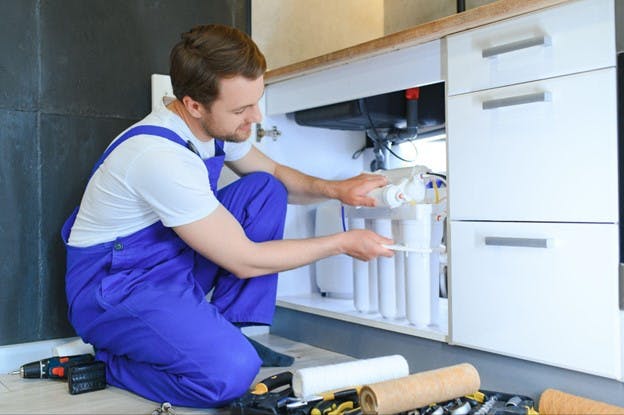January 2024
Unlocking Pure Water: Understanding RO Systems
Your tap water makes quite the journey to get to you. It comes in contact with rocks, dirt, chemicals, pipes, algae, and probably some wildlife. And because water is a solvent, it tends to pick up a lot of contaminants on its way.
Some of these are just nuisances, altering taste or appearance, while others pose real health risks. Understanding which specific contaminants are in your water is crucial for choosing the most effective treatment method to remove them. While myriad water treatment and filtration methods exist, reverse osmosis (RO) stands out for its ability to remove more contaminants than most others. But just like all water filtration methods, RO systems have both strengths and weaknesses you need to know about.
In this article, we’re diving deep into RO systems. We’ll be exploring variations like tank-based and plumbed setups. Then we’ll see how RO compares with other filtration methods such as ultrafiltration and activated carbon filters, and we’ll help you figure out if reverse osmosis systems are right for you.
What Is a Reverse Osmosis System and How Does It Purify Water?
Reverse osmosis is a water purifying process where water is forced through a semi-permeable membrane which separates water molecules from contaminants. The pores in the RO membrane are often smaller than one nanometer (one-billionth of a meter), so almost nothing but the water molecules can make it through.
RO is one of the most effective methods for water purification we have. It is only rivaled by distillation, which is a much more energy-expensive process. Home RO systems are usually part of multi-stage drinking water systems that can include sediment filters, activated carbon pre-filters, ultraviolet light, water softeners, remineralization filters, and water polishers that give you clearer, cleaner, better-tasting drinking water.
What Types of RO Systems Are Available for Home Use?
There are many types of reverse osmosis water filters you can buy for your home, from whole house filters to countertop units to everybody’s favorite, the under-sink RO systems.
The undersink models have been providing families with filtered water from their tap for decades. These have remained popular because they are affordable, easy to install, and reliable. They also tuck away under your sink so you don’t lose any precious counter space.
Up until recently, these were all tank systems, meaning there’s a tank usually under the sink that stores purified water. While the tank systems are still favorable for most people, there are now tankless systems entering the market as well.
What’s the Difference Between Tank and Plumbed (Tankless) RO Systems?
Reverse osmosis water filtration systems are the best for getting great-tasting, pure water from your faucet. But forcing a lot of water through the microscopic holes of a reverse osmosis membrane can take a while. When you turn on your tap, you probably don’t want to wait, and you definitely don’t want your filter to harm your flow rate and water pressure.
This is why most home RO systems have a water tank attached. The tank allows water to be filtered throughout the day and be captured in the tank. This way, when you turn on the tap, there’s a tank full of clean water ready to go at all times. With a tank, you don’t lose water pressure, you always have a clean water supply available, and there’s no special plumbing requirements to install it.
On the downside, you may need to clean or flush these tanks from time to time, especially if you haven’t used the faucet in a while. The tank also takes up some space under your sink.
The alternative to the tank RO filters is the plumbed or tankless RO water filter system. Instead of storing water up in a tank, the tankless models use a high-pressure pump to force water through the membrane faster, so it’s filtered when you need it. The major benefit to these is that you can fit this unit in a smaller space. No tank also means no risk of bacteria growth.
There are several downsides to the tankless RO systems. They are usually more involved systems that require professional installation. And because they require you to have high water pressure, the use of energy-hungry, electric booster pumps is often required. And even with that, these systems usually end up restricting the flow rate and water pressure you get from your tap and showerhead.
Finally, in a tank system, even if you lose water service, you have a reserve tank of clean water waiting for you. With the tankless models, interruptions in power or water service could mean your tap can’t flow.
How Do Reverse Osmosis Systems Compare to Other Drinking Water Filters?
We all want high quality, great-tasting water from our faucets. With so many types of water filtration systems to choose from, it’s important to know how RO systems stack up in terms of removing water contaminants.
Reverse Osmosis (RO) Systems
RO systems are highly effective in reducing most types of water contaminants including total dissolved solids (TDS), heavy metals, microorganisms, and nitrates. They also excel at removing disinfection byproducts and reducing hard water minerals like calcium. There are some contaminants, like fluoride, that can only be removed using reverse osmosis.
Ultrafiltration (UF) Systems
UF is similar to RO in that both push water through a membrane. The major difference is that the pores in RO filters are smaller, so fewer contaminants get by. UF shines in situations where the removal of larger particles, bacteria, and some viruses is necessary but efficiency and keeping a high flow rate are also important.
UF filters don’t get a lot of use inside homes and they aren’t good for removing dissolved solids or smaller contaminants. They can sometimes be used as pre-filters for RO systems in very polluted water.
Activated Carbon Filters
Activated carbon filters are the most common types of water filters. Activated carbon is cheap and abundant. As a substrate, it’s particularly good at removing chlorine, chloramines, and organic compounds, significantly improving the water's taste and smell. They are also effective against some heavy metals and disinfection byproducts. However, they don't reduce TDS or fluoride as effectively as RO systems. In multi-stage RO setups, activated carbon acts as a pre-filter to the RO membrane.
Ultraviolet Light
Ultraviolet light is often used as a way to disinfect water without chemicals like chlorine. UV filters don't actually filter water but instead deactivate viruses and other harmful microorganisms so they can no longer replicate and cause problems. It’s important for water treated by UV light to be pre-filtered for sediment since pathogens can sneak past in the shadows caused by these particles.
What Are the Primary Contaminants That RO Systems Are Effective at Removing?
Reverse osmosis water filters are known to remove as much as 99% of impurities from water. Only the smallest particles make it through the microscopic holes of the RO membrane. A few of the water contaminants that are easily captured by most RO systems are:
- Sediment
- Chlorine
- Total dissolved solids
- Barium
- Cadmium
- Hexavalent and trivalent
- Chromium
- Lead
- Copper
- Radium 226/228
- Selenium
- Fluoride
- Nitrate/nitrite
While some of these, like chlorine, can slip through or even damage the membrane, the majority of RO systems have multiple stages that are designed to maximize the membrane’s effectiveness. For example, an activated carbon filter placed before the RO membrane will remove the chlorine before it can cause damage.
What Factors Should You Consider When Choosing a Reverse Osmosis System for Your Home or Business?
When picking the perfect reverse osmosis system, make sure the one you choose fits your needs. Try to find a balance between producing enough purified water for daily use, ease of installation, and hassle-free maintenance. Here’s a few factors to keep in mind.
Capacity
With most RO systems, there’s a daily limit to the number of gallons per day (GPD) that can be purified. These limits are usually high enough for your average household but it's worth looking at if you are installing it in an office or you have a big family. If you buy a tank system, be sure the tank is big enough for your needs.
Flow Rate and Water Pressure
Some systems, like the tankless variety, require you to have high water pressure or booster pumps to make them work. But you may not get that same pressure out of your tap once your system is installed. Make sure the RO system you choose keeps your water pressure intact.
Water Quality
If you’re buying a water filter, it's likely because you want better water. While reverse osmosis models will handle most contaminants, you still want to make sure it’s capable of removing contaminants that are important to you.
Installation Requirements
Some RO systems are easy to install. Others will require alterations to the plumbing in your home or business. Take a look at the installation requirements before you decide.
System Size
Consider the available space to accommodate the system, especially for under-sink or countertop models in homes or smaller business premises. If you can’t make it fit where you want it, there may be a better solution.
Maintenance
Like anything you buy, there’s going to be some maintenance required to keep it working as you’d expect. Some RO systems are designed to be easy to maintain and easy to find replacement filters for. Others will require a plumber visit. Check the manual or ask the manufacturer for information on what’s required for maintenance before you buy.
What Are the Maintenance Requirements for RO Systems?
Proper maintenance is vital to keeping your reverse osmosis system functioning efficiently and ensuring the longevity of the system. Here’s how to stay on top of your RO system’s maintenance.
Regular Filter Changes
- Pre-filters and post-filters: These should typically be replaced every 6-12 months. They protect the RO membrane by trapping sediment and chlorine that can clog or damage it.
- RO membrane: The heart of the system, the RO membrane usually needs replacement every 2-3 years, depending on the water quality and usage.
Tank Draining and System Sanitization
If you have a tank, it's recommended that you drain it every few weeks to ensure no bacteria is growing in the tank. Then about once per year you should sanitize your entire system, including the storage tank. It’s a good idea to do this during filter changes. After the new filters are in, take a minute to check for leaks or damage.

Is a Reverse Osmosis System Right for You?
When it comes to removing a wide range of contaminants from your tap water, nothing beats reverse osmosis. With the variety of RO systems available, understanding the differences is crucial to finding the one that best suits your home or business needs.
At HomeWater, our made-in-America water filters are intelligently designed with efficiency, affordability, and ease of installation and maintenance in mind. Our HomeWater 4-Stage Reverse Osmosis Under Counter Water Filter is made to reduce sediment, dirt, chlorine, dissolved inorganics, barium, cadmium, hexavalent and trivalent, chromium, lead, copper, radium 226/228, selenium, fluoride, and nitrate/nitrite.
Experience the difference in water quality with a HomeWater filter.

